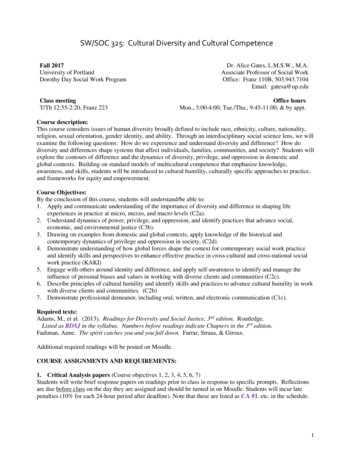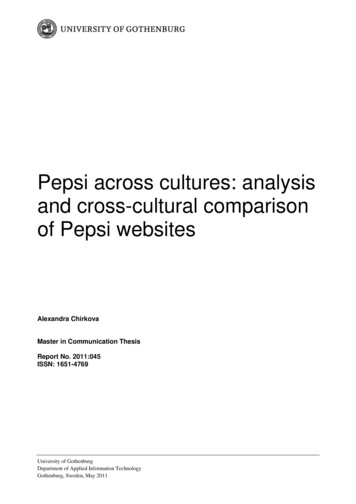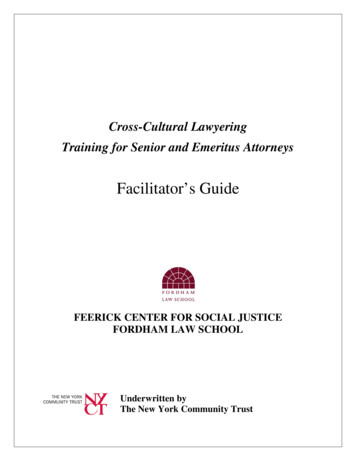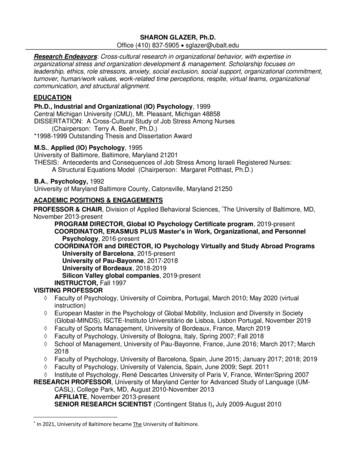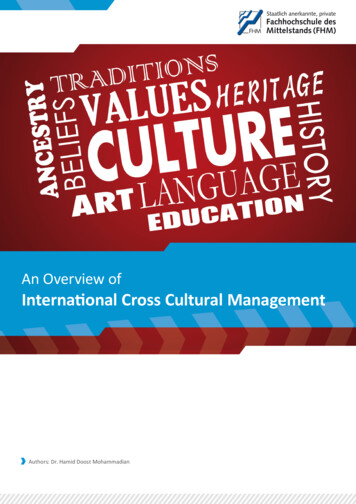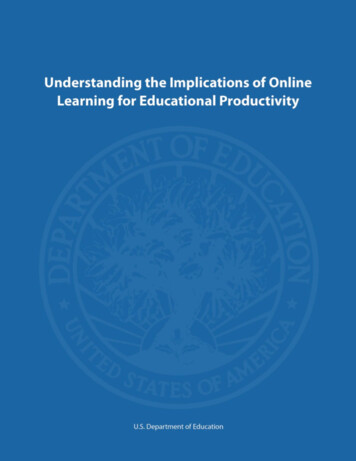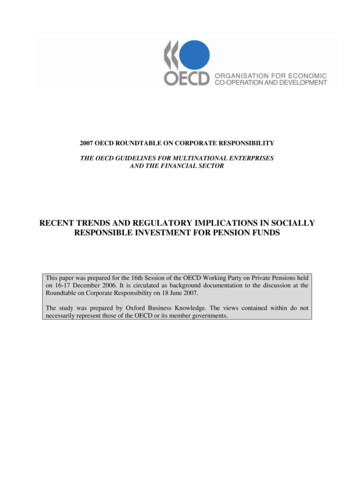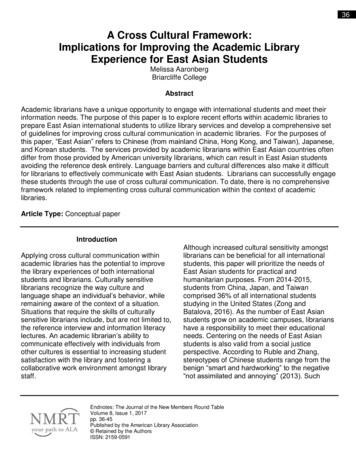
Transcription
36A Cross Cultural Framework:Implications for Improving the Academic LibraryExperience for East Asian StudentsMelissa AaronbergBriarcliffe CollegeAbstractAcademic librarians have a unique opportunity to engage with international students and meet theirinformation needs. The purpose of this paper is to explore recent efforts within academic libraries toprepare East Asian international students to utilize library services and develop a comprehensive setof guidelines for improving cross cultural communication in academic libraries. For the purposes ofthis paper, “East Asian” refers to Chinese (from mainland China, Hong Kong, and Taiwan), Japanese,and Korean students. The services provided by academic librarians within East Asian countries oftendiffer from those provided by American university librarians, which can result in East Asian studentsavoiding the reference desk entirely. Language barriers and cultural differences also make it difficultfor librarians to effectively communicate with East Asian students. Librarians can successfully engagethese students through the use of cross cultural communication. To date, there is no comprehensiveframework related to implementing cross cultural communication within the context of academiclibraries.Article Type: Conceptual paperIntroductionApplying cross cultural communication withinacademic libraries has the potential to improvethe library experiences of both internationalstudents and librarians. Culturally sensitivelibrarians recognize the way culture andlanguage shape an individual’s behavior, whileremaining aware of the context of a situation.Situations that require the skills of culturallysensitive librarians include, but are not limited to,the reference interview and information literacylectures. An academic librarian’s ability tocommunicate effectively with individuals fromother cultures is essential to increasing studentsatisfaction with the library and fostering acollaborative work environment amongst librarystaff.Although increased cultural sensitivity amongstlibrarians can be beneficial for all internationalstudents, this paper will prioritize the needs ofEast Asian students for practical andhumanitarian purposes. From 2014-2015,students from China, Japan, and Taiwancomprised 36% of all international studentsstudying in the United States (Zong andBatalova, 2016). As the number of East Asianstudents grow on academic campuses, librarianshave a responsibility to meet their educationalneeds. Centering on the needs of East Asianstudents is also valid from a social justiceperspective. According to Ruble and Zhang,stereotypes of Chinese students range from thebenign “smart and hardworking” to the negative“not assimilated and annoying” (2013). SuchEndnotes: The Journal of the New Members Round TableVolume 8, Issue 1, 2017pp. 36-45Published by the American Library Association Retained by the AuthorsISSN: 2159-0591
Endnotes 8.1stereotypes have the potential to negativelyinfluence the academic and social experiencesof Chinese students. Culturally sensitivelibrarians can play a pivotal role in creatingspaces that encourage diversity and tolerance.The purpose of this paper is to develop aframework for improving cross culturalcommunication in academic libraries. Buildingupon the best practices and strategies outlined inthe current literature, this framework willemphasize collaboration, cultural education,practical application, and assessment. Thispaper will explore the studies related to thelibrary use of East Asian students, and howthese experiences present both challenges andopportunities. The proposed framework will focuson the following components: collaborationbetween librarians, other university departments,and students in order to foster cross culturalcommunication, a cross cultural training programfor librarians that includes a variety of formats tooptimize learning, empowering librarians topractically apply cultural sensitivity on the job,and the importance of self- and managerassessments in determining how to utilize crosscultural communication in the long term.Literature ReviewEast Asian Students and the AcademicLibraryThe current body of literature regarding theinternational student experience in Americanacademic libraries provides a valuablefoundation with which to further examine theexperiences of East Asian students. Manyauthors have taken into consideration thedifferences between East Asian and Americanuniversity libraries, and have developedsuggestions to improve library services for EastAsian students. These authors advocated forincreased collaboration between library staff andfaculty in promoting diversity. Another commonrecommendation within these studies is toprovide resources for using the library inlanguages other than English. The themespresent in the current body of literature evolvedfrom general guidelines relating to internationalstudents to a nuanced approach of theexperiences of East Asian students.Early literature regarding international studentsin academic libraries identified the linguistic andcultural barriers that impacted these students’library use. In their 1987 seminal article “Foreignstudents, libraries, and culture”, Ball andMahoney identified the unique linguistic andcultural struggles international students facewhen interacting with academic librarians. Theserange from differences in the perceivedacceptability of maintaining eye contact to beingunaware of the services reference librarians offer(Ball & Mahoney, 1987, p. 163). Ball andMahoney also identified possible misconceptionsand prejudices academic librarians may havetowards international students, and imploredacademic librarians to be cognizant of culturaldifferences. The authors also note thedifferences between American university librariesand international libraries, such as theeducational background of librarians and theaccessibility of the stacks (Ball & Mahoney,1987, p. 164). Ziming Liu similarly identified thedifficulties Asian students encountered usingopen stacks and card catalogs (1993). Althoughthe authors’ suggestions on how to implementcross cultural communication in the referenceinterview are achievable in many academiclibraries, both Ball and Mahoney and Liu did notattempt to predict any student populationchanges or technology trends that may affecthow international students interact with librariansin the future.By the twenty-first century, scholars incorporatedthe perspectives of academic librarians in theiranalyses. In “Communication in academiclibraries: An East Asian perspective,” Zhangprovides a comprehensive set of possibleservices academic librarians can offer EastAsian students. Zhang suggested that librariesgive handouts in both English and East Asianlanguages with a map of the stacks and a list ofcommon library terms with their definitions(Zhang, 2006, p. 172). Zhang emphasized theimportance of hiring librarians from multiculturalbackgrounds and liaising with faculty membersto develop programs and workshops on diversity(Zhang, 2006, p. 172). Similarly, Mu suggested37
38Endnotes 8.1liasing with International Student Services andmaking the library’s website more user friendly in“Marketing academic library resources andinformation services to international studentsfrom Asia” (Mu, 2007, p. 574). Mu’s work took aholistic approach regarding students from Asia,whereas Zhang focused exclusively on EastAsian students.Another prominent suggestion in the currentliterature involved hiring librarians who specializein East Asian culture and languages. Afterobserving the library use of Chinese engineeringstudents at the University of Oklahoma in 2012,Chen and Brown determined that “fostering andpromoting an understanding of Chinese cultureand Chinese university library systems byrecruiting culturally sensitive librarians andcontinuing education will help providecustomized library services that meet Chineseengineering graduate students' informationneeds and in turn enhance their educationalexperiences in the United States” (Chen &Brown, 2012, p. 341). According to Shao,Scherlen, Johnson, Xu, and Hu’s “Chinesestudents in American academic libraries: Asurvey of Chinese user satisfaction with U.S.library experience,” 42% of those studentssurveyed answered “no” as to whether they werehelped by a librarian who specialized in assistingstudents from China (Shao, et. al, 2013, p.30).Furthermore, 73% of students surveyedanswered “no” to questions concerning whetherthe library’s website was available in Chineseand whether the stacks contained Chineselanguage materials (Shao, et. al, 2013, p.30).Based on these findings, increasedmulticulturalism within the library’s staff willgreatly benefit the user experiences of EastAsian students.Academic Expectations and Perceptions ofthe LibraryAcademic libraries within East Asian countriesdiffer from those found in American colleges anduniversities, and this informs an East Asianstudent’s understanding of what services thelibrary offers. Confucian values are reflected inmany East Asian university curriculums in theform of “observing, rote learning, and imitating,”as opposed to learning by participation andcritical thinking within American universities(Zhang, 2006, p. 167). Although the term “SuzhiJiaoyu,” which refers to a “quality” or holisticeducation, has made its way into Chinese highereducation since the 1990s, many Chinesestudents entering American universities arefamiliar with an exam based education asopposed to an education based on criticalthinking (Shao, Scherlen, Johnson, Xu, & Hu,2013). Similarly, Japanese students oftenmisunderstand American assignment guidelinesand are unfamiliar with the expectation to usemultiple sources rather than one textbook(Ishimura, 2013, p.22). In general, East Asianstudents are also unfamiliar with the concept ofplagiarism and often do not have experienceciting sources (Mu, 2007, p. 573). Whenconsidering these observations, however, it isnecessary not to stereotype East Asian studentson an individual level, as Ruble and Zhang warn(2013).Another key difference separating East Asianacademic libraries from those in the UnitedStates is the role of the librarian. According toMu, librarians in many Asian countries do notanswer reference questions or provide individualconsultations on a specific subject (Mu, 2007, p.573). As a result, East Asian students areunaware that American academic librarians areavailable to answer reference questions (Mu,2007, p.573). Although some librarians mayprovide reference services to students in EastAsia, many students do not necessarily use thatservice as most of their work is based on examsand textbook reading (Mu, 2007, p.573).Furthermore, librarians in East Asia are notrequired to hold a Masters in Library Sciencedegree (Mu, 2007, p.577). Mu succinctly statedthat East Asian students “tend to view the libraryas a place to study and librarians asbookkeepers rather than information providers”(Mu, 2007, p.573). Open communicationbetween librarians and students is a key step inadvertising the credentials and expertise of thelibrary staff.The experiences of East Asian students inmeeting their information needs are aninvaluable resource to consider when developing
Endnotes 8.1library services. In Japan, 80% of universitylibraries provide information literacy courses, butonly 10% provide academic support services(Donkai, Toshimori, & Mizoue, 2013). East Asianstudents studying in the United States often turnto others in their peer group to gain information.According to a study at the University ofMaryland, “web searches, online/mobile maps,friends, and online communities were among thetop five information sources” for Chinese andKorean students (Oh, Butler, & Lee, 2014, p.1).Freshmen Chinese and Korean students usedoften their student associations’ social mediapages to connect with senior students to sharehelpful information (Oh, Butler, &Lee, 2014, p.1).Results from the questionnaires and interviewsshow that the participants valued “informationthat is essential for their living, navigating, andsettling in the unknown environment thaninformation that is helpful for recreation” (Oh,Butler, &Lee, 2014, p.7). Mu argued in favor ofdeveloping a comprehensive information literacycurriculum for international students comprisedof online tutorials on using the library catalog andwebsite, developing critical thinking skills, andlearning research methods (Mu, 2007, p.575).For example, librarians at the main campus ofRutgers University developed library orientationprograms and instructional booklets in English,Chinese, and Korean (Liestman and Wu, 1990).This program fulfilled a need for libraryinstruction in East Asian languages. Postorientation assessments showed that studentsfound the orientation informative. As Lo, Sun,Womack, Wu and Yang observed two decadeslater, however, these efforts only targeted walk instudents and those students who attendedlibrary orientation, and was a missed opportunityto reach out to other East Asian students (Lo,et.al, 2009). Information literacy instruction thatreflects the technology use of internationalstudents has the potential to acclimate EastAsian students into an unfamiliar library.Furthermore, observing the information seekingbehavior of international students may be thekey to overcoming linguistic and cultural barriers.Allen’s 1993 survey, “International students inacademic libraries: A user survey,” assessedhow international students perceived and usedthe library. By examining the computer habits ofinternational students, Allen observed that manystudents whose first language is not English haddifficulty using library terminology. Many termsthat are common in American libraries do nothave an equivalent in other languages. Allensuggested that librarians must recognize thedifferent information needs of undergraduate vs.graduate students and plan accordingly (Allen,1993, p.333). According to a 2003 study byWhitmire, international students of color aremore likely to use the library to read or study,ask the librarian for help, and use basicreference services than native born whitestudents (Whitmire, 2003, p.150). This researchindicates that international students arebecoming more aware of the services withinAmerican academic libraries, but still requireguidance from librarians. Cross culturalcommunication is a viable tool in providing libraryservices to international students who may havea different cultural understanding of whatservices the library offers.Cross Cultural Training Programs in ReviewThere is a consensus within the current literatureregarding the components of a successful crosscultural training program, which includes relevantcultural content and the use of differentinstruction formats. For many authors, culturalawareness must be at the center of crosscultural training programs. According to Wangand Frank, training programs must first identifythat cultural differences exist, and then recognizethat although an individual’s behavior is shapedin part by their culture, context is always key(2002). Based on her experiences working withIndigenous collections in Australian libraries,Blackburn argued that the first step in crosscultural communication must be an appreciationfor other cultures while also assuming that bothsides of the cultural divide are acting in goodfaith (2009). Brislin and Toshida also argue infavor of teaching cultural awareness. In theirview, cultural differences are often taken forgranted in everyday life (similarly to breathing),but that reflecting on these differences fosterscross cultural understanding (Brislin & Toshida,1993).39
40Endnotes 8.1A cross cultural training program that recognizesthe different learning styles of students byutilizing a range of teaching methods and courseformats has the potential to increase studentlearning. Brislin and Toshida recommended thatcross cultural training exercises should includerole playing, group discussions, tasks dependenton diverse contributions, and “homeworkassignments” that require students to apply whatthey learned in their own social circles (1993).Brislin and Toshida also suggested that roleplaying exercises address the emotionalchallenges that may be encountered whenlearning a new way to communicate (1993).Similarly, Rosen, Spatz, Gaaserud, andAbramovitch argued in favor of centering crosscultural training workshops on group discussion(2004). For Putranto, Gustomo, and Ghazali,field trips to culturally relevant destinations wereshown to be the most conducive to studentlearning (2015). According to these authors, adiverse curriculum provides multipleopportunities for student engagement based onpost-assessment questionnaires.Limitations to Cross Cultural CommunicationA significant development in the current literatureis an examination of the limitations of crosscultural training. In their deconstruction ofcultural intelligence, Dutta and Dutta “critique thediscursive moves through which CQ is presentedas a competitively advantageous tool for globalorganizations, deconstruct its theorization andmeasurement, and discuss its role inperpetuating transnational hegemony” (2013).According to Dutta and Dutta, the scholarshipsurrounding cultural intelligence training does nottake into consideration how transnationalorganizational practices perpetuateunemployment and exploitation abroad (2013).In contrast, Hampden-Turner and Trompenaarsargued that cross cultural training synthesizesdifferent cultural experiences into a unified whole(2006). One opportunity for further research isexamining the correlation between organizationsthat send employees abroad and any shifts incultural norms of the local population.The Benefits of Cross CulturalCommunicationIn order to provide the best services to studentsregardless of their cultural backgrounds,academic libraries ideally must become globallibraries. A cross cultural communicationframework is necessary to aid librarians indismantling any linguistic and cultural barriersthat impede a student’s educational path.Communication styles are often informed bycultural values and mores. According to Zhang,the high context communication style prevalentamong East Asians has its roots in theConfucian ideals of respect and conflictavoidance (Zhang, 2006, p. 167). Speakers whouse high context communication often rely onimplied meanings, and put the burden ofunderstanding upon the listener (Zhang, 2006, p.167). In contrast, low context speakers (such asthose in the United States) rely on clear andexplicit messages while placing the burden ofcommunicating effectively on the speaker Zhang,2006, p. 167). Consequently, at the referencedesk, an East Asian student may nod while alibrarian speaks as a gesture of politeness andattentiveness, but may not full understand whatthe librarian is explaining (Zhang, 2006, p. 167).High context speakers also focus on unified orcircular logic, whereas those from low contextcultures prefer analytical thinking (Zhang, 2006,p168). East Asian students are more likely tostart with general questions at the referencedesk and then arrive at specific questions, whichmay be confusing for librarians who areaccustomed to speaking in the specific firstfollowed by general supporting statements(Zhang, 2006, p. 168).Non-verbal communication may also presentchallenges during the reference interview. Nonverbal communication includes tone of voice,eye contact, facial expressions, and the conceptof personal space (Zhang, 2006, p.169). At thereference desk, an East Asian student may avoiddirect eye contact with a librarian as a sign ofrespect, but the librarian may interpret this asdisinterest or inattentiveness (Zhang, 2006,p.169). Some forms of non-verbalcommunication differ between East Asiancultures. Chinese speakers often smile to
Endnotes 8.1express embarrassment or frustration, butKorean speakers only smile during assuredinstances (Zhang, 2006, p.169). Librarians mayinterpret not smiling as a sign of hostility,similarly
Briarcliffe College Abstract . of online tutorials on using the library catalog and website, developing critical thinking skills, and learning research methods (Mu, 2007, p.575). For example, librarians at the main c
